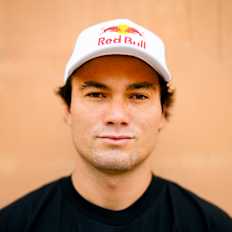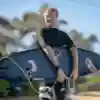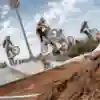Skateboarding

Skateboarding
Now's the time to learn everything there is to know about skateboarding
From its origin story to the key tricks and techniques used by the stars of today, discover all you need to know about the world of skateboarding.
01
Skateboarding: the short version
Skateboarding is the activity that has come to define urban cool. Since its creation in 1960s California, skateboarding’s simplicity and accessibility has seen it flourish around the world. Through highs and lows of popularity, skateboarding has become a multi-billion dollar industry whose leading practitioners are famous throughout the world via the mediums of video, gaming and huge brand endorsements. Meanwhile, 2021 saw skateboarding cross a huge cultural threshold when it debuted on the greatest athletic stage in the world in Tokyo, Japan.
02
The origin story
Skateboarding as we know it started in the late 1960s in California where surfers would use schoolyard banks to emulate waves on flat days – hence ‘sidewalk surfing’. Surf companies then started making skateboards. The invention of urethane wheels, which offered more grip and speed, was pivotal. In the mid-1970s, California experienced a severe drought. Swimming pools were drained and local skateboarders rode the smooth, empty pools.
It was here that vertical transition skateboarding was born. In the '80s, a new breed of skateboarders like Christian Hosoi, Steve Caballero and Tony Hawk pushed the limits of Vert skateboarding. In parallel Florida’s Rodney Mullen was stunning the world with his unbelievable trick repertoire on flat ground. Widely considered the most pivotal innovator in the history of skateboarding, many of the tricks Mullen invented would form the basis of modern street skating.
As the '80s gave way to the ‘90s, advances in home technology increased skateboarding's allure exponentially, while board shapes stabilised around the ultra-functional, duo-directional ‘popsicle’ shape which dominates today.
Nowadays skateboarding is one of the world's most popular action sports. Its heroes are household names with giant followings. The women's skateboarding scene is also ever-growing. Competitive skateboarding has become so advanced in terms of difficulty and consistency, that skateboarding has debuted on the world's biggest sporting stage, the Olympics, where competitors from all over the world skated it out for medals and glory in the disciplines of Street and Park.

10 min
Skateboarding vs sports
At the end of the day, what is it that makes skateboarding different from other sports?
03
What are we watching, exactly? How does skateboarding work?
From a competitive perspective, the two biggest categories of contest these days are Skatepark Street and Skatepark Bowl.
Street
The Skatepark Street discipline utilises a mash-up of obstacle terrain intended to broadly reflect the urban architecture upon which this genre was created – stairs, railings, banks, ledges, benches and so on.
Bowl
Skatepark Bowl is a transition-based milieu where interwoven, flowing capsule bowls (usually made of rock-hard concrete!) are charged around linking huge air tricks and high-speed lip manoeuvres in a (hopefully) continuous timed run. Each contest permutation is judged behind different criteria, which seeks to eliminate repetition or conservative trick selection and both are clearly highly-skilled and yet ever-dangerous endeavours. Accidents can and do happen, even at this elite level.
Judging criteria
Skateboard contest judging tries to strike a balance between consistency and creativity. Judges score individual timed runs on the following:
- Use of the entire course
- Difficulty and technicality of tricks
- Execution (clean landings)
- Variety of tricks
- Speed, flow and style
- Consistency (lack of mistakes)

12 min
Core or contest?
Jagger Eaton, Ryan Decenzo and Samarria Brevard demonstrate the differences between park and street skating.
04
I want a go. What kit do I need for skateboarding?
Part of skateboarding’s beauty is the simplicity of the equipment. The skateboard is made up of the wooden deck, upon which the skater stands, and the trucks which operate as steering axles. On those trucks there are a total of four wheels, each with a pair of eight ball bearing races countersunk into the core of the wheel, which allows the skaters to hit those high speeds required to leap across great distances or high in the air.
Skateboard decks
The deck is always made of seven rectangular veneers of Canadian maple, cross-laminated for strength and glued together with epoxy resin before being shaped for weeks under thousands of pounds per square inch of steam pressure and being cut into the requisite shape. Modern skateboards have a duo-directional shape allowing for any trick to be done going either forwards or backwards (‘fakie’) or indeed in the opposite stance from the skater’s natural choice of leading foot (‘switchstance’).
Broadly speaking, transition-based skateboarding favours large board shapes (often as much as nine inches in width) with broad, impact-resistant nose and tail shapes, whereas street skaters prefer narrower board shapes (occasionally as small as 7.5 inches in width) which are lighter, spin faster and which have a tapering front and back incline that can be flicked more precisely to govern rotations.
Trucks
The trucks are forged with a high-strength axle to prevent snapping and the steering responsiveness is governed by the durometer of the cushioned bushings in the offset vertical steering column of each: soft rubbers provide a loose steer and tighter turns, stiff rubbers offer stability and reduce the chance of wheelbite on the deck underside during high-impact landings.
Bearings
At elite level, the bearings tend to be either Swiss-engineered custom ball bearing races or, more recently, cast ceramic ball bearings, which are finished to such a high polish that they offer only minimal energy loss through friction, despite the G-forces exerted on them.
Wheels
Skateboard wheels today are made of urethane, a polymer developed by DuPont which has a density measured on a durometer scale peaking at 100a. Transition skaters favour large wheels (around the 58-60 millimetre diameter mark) with a broader running surface and a grippy durometer around the 97a mark, whereas street practitioners prefer smaller-diameter wheels in the low 50s (which are more responsive to small balance adjustments) and a higher durometer, which allows for controlled skidding and sliding out of tricks. What makes urethane perfect as a wheel is that the heat generated by skateboarding does not degrade the polymer.

12 min
The best wheels in skate
Help us settle an argument: what are the best wheels in skateboarding?
05
The tricktionary – what are skateboarding's key tricks and techniques?
Ollie
Named after its inventor Alan 'Ollie' Gelfand, the ollie is the building block of today’s skateboarding. A no-handed air achieved by striking the tail of the board off the ground and then guiding the rebound through the air just by foot traction, the ollie evolved into a myriad of variations, the more common of which we have listed below.
Shove It
An ollie where the tail strikes the ground at a 45-degree angle, thereby causing the impact energy to reverse the axis of the board 180 degrees laterally underneath the skater’s feet.
Kickflip
The trick which made skateboarding explode in public consciousness: an ollie in which the leading foot flicks the rebounding board into a full single rotation along its length before being again in mid-air and guided back to terra firma. A well-executed kickflip can look like magic.
Heelflip
Essentially, a kickflip spun the opposite direction. Heelflips are less common than kickflips because they are less precise and very unforgiving if the skater makes an error of judgement!
Grinds / slides
Using the various sections of the wooden skateboard (slides) or metal undercarriage (grinds) to assail the edges of the terrain the skateboarder is riding. Slides and grinds are often combined with other tricks into or out of them in order to create ever more challenging and complex permutations!
Nollie
An ollie using the nose of the board as opposed to the tail. The reversal of energy flow requires a total recalibration of the skateboarder’s mind to process the technique for tricks which begin with a nollie; therefore nollie tricks are considered more difficult and rewarded accordingly.
Grabs
The art of grabbing the skateboard mid-flight is more about style than necessity. Each section of the board can be grabbed with either hand to produce flourishes, tweaks and stretches which demonstrate control and finesse.
Switchstance
Not so much a trick as an inversion of form, skateboarding ‘switch’ is effectively going backwards – riding in the opposite direction of one’s preferred combat stance. Recreating any move switchstance is the skateboarding equivalent of learning how to play golf the other way around, but with much more dangerous consequences from any errors arising from miscalculation!
06
Names to watch out for
- Pedro Barros – Barros is considered the best concrete skater of his or possibly any generation.
- Leticia Bufoni – In 2019, Bufoni was selected to be a member of Brazil’s first-ever national skateboarding team.
- Zion Wright – Wright has taken the skate world by storm with his defined style and charismatic charm.
- Brighton Zeuner – American skateboarder Zeuner became the youngest person ever to win X Games gold at the age of 13.
- Alex Sorgente – Sorgente was selected by USA Skateboarding to join the first team of hopefuls competing to qualify for the 2021 Summer Games.
- Margie Didal – Didal is a skate wunderkind from the city of Cebu in the Philippines, who harbours ambitions of representing her nation on the biggest of stages.
07
Where can I see more?
Films
Skateboarding culture is immersive and unique – it reaches into the worlds of architecture, design, fashion, photography, video, art, travel and philanthropy. One of the biggest cultural drivers within skateboarding in recent years has been the explosion of participation – particularly within women’s skateboarding. Enjoy these deep dives into the world of skateboarding!
Events
- Red Bull Rio Conquest – 2023 will see the Red Bull Conquest series visit Rio after events in Paris and Lisbon. The format is a one-on-one sudden-death knockout, with judges choosing round winners based upon overall rider impression within a three-minute jam, rather than scoring trick tallies.
- Street League Skateboarding – Professional skateboarding’s international touring stadium street contest series.
- Vans Park Series – The definitive bowl skating series, where skateparks are often built for the event and then donated to the host city.
- Tampa Am/Pro – The most democratic way to make a name for yourself in skateboarding competition is at Tampa, where the eyes of the industry are.
- Vans Pool Party – Taking place at the Vans Combi Pool in Orange County, California, this is a who’s who of concrete carnage across the generations.
- X Games – Now in its 25th year, the first made-for-TV action sports festival still attracts the biggest names in contest skateboarding.
Check out Jagger Eaton's playlist below, or head over to Spotify to hear it there:
Part of this story

























